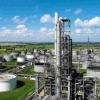"There are two exchangers in parallel and this happens in the first exchanger"
In parallel configuration there is no first or second, ideally both gets 50%-50% of flow with same inlet conditions. There is a possibility that due to configuration the distribution is not 50-50.
Let us take a hypothetical case where distribution in A & B is 60% and 40% at 18 Barg operation. Pressure drop in both A & B circuit will be same, let us assume 0.5 Bar. In this case wrt design load of 50% in each, A is operating at 60/50 = 120% load where as "B" is operating at 40/50 = 80% of design load.
Now if the pressure is reduced, flow will increase linearly. .
The volumetric flow will increase by 19/15 = ~ 127%. The distribution will be 1.27*0.6=76% in "A" and 51% in "B" (total 127%)
The pressure drop will increase to 0.5 *(1.27)^2 = 0.8 bar for both the exchangers.
Kindly note that now A is operating at 76/50 = 152% load where as "B" is operating at 51/50 = 101% of design load.
Thus you can now see a significant difference of heat load, exchanger designed may work at 120% utilizing all excess area as in case of 18 Barg pressure, but at 14 Barg "A" exchanger is subjected to 152% of design load and hence pose limitation, whereas exchanger "B" is operating at 80% to 101% of design load and can cater your requirement.
Kindly check the flow distribution in your existing configuration.
Other point-
NH3 vap pressure data-
@ 48°C = 18 Barg, @38°C = 14 Barg. If the pressure is reduced, condensing temperature will reduce hence reducing LMTD. This will reduce heat transfer in both the exchangers.

 FB
FB














